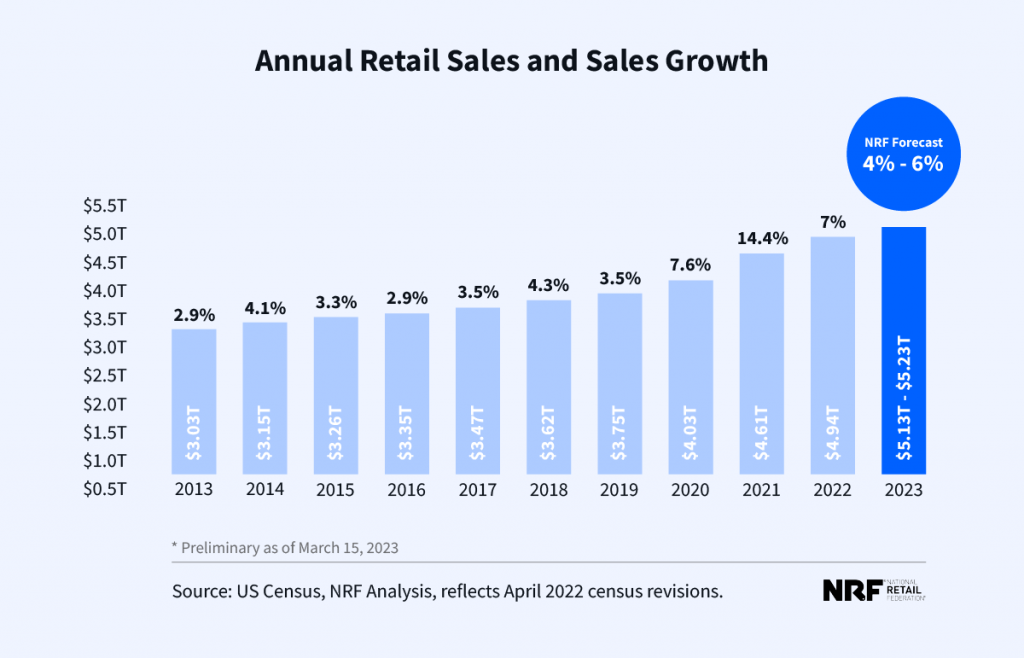Planning your holiday marketing campaign typically begins in July, so the time is now! Getting an early start means you’ll have time to craft holiday marketing ideas that take into account current trends, emerging digital channels, and the expectations of consumers going into this holiday season.
Ready to spruce up your holiday marketing strategy? Read on to learn everything you should know ahead of campaign planning.
Past Trends to Inform Your Holiday Marketing Ideas
Looking at historical data is beneficial to planning programmatic campaigns that perform, but this especially rings true for seasonal campaigns like holiday shopping.
Below, we’re sharing some of the biggest takeaways from the 2022 holiday season. This data can provide you insights into what the 2023 season might look like, and the consumer mindset.
Retail Sales Are Growing
According to the National Retail Federation (NRF), 2022 saw significant growth in retail sales compared to the prior year. Sales grew by 7%, with retail sales reaching $4.9 trillion USD. November to December holiday sales saw year-over-year gains in all but two of nine retail categories, led by online sales, grocery stores, and general merchandise stores.
Toys Are a Leading Retail Category
Unsurprisingly, toys sell very well during the holiday season–particularly online. In 2022, the toy category saw sales grow 206% compared to pre-holiday season levels, according to Adobe Analytics. Video games (up 115%) and apparel and accessories (up 94%) also saw strong demand.
Top toys in 2022 (sold online) included Squishmallows, Roblox figurines, Pokémon card games, and LOL Surprise dolls. Top electronics and gaming devices included PlayStation 5, Xbox Series 5, Nintendo Switch, and Apple products like the iPhone, iWatch, and AirPods.
Black Friday 2022 Set Records
In 2022, more than 166 million Americans shopped either in-person or online over the five day period from Thanksgiving Day through Cyber Monday. US retail consumers spent a record $9.2 billion USD online on Black Friday in 2022, which is an increase of 2.3% year over year, according to Adobe Analytics. Salesforce Inc. reported that US Black Friday online retail sales reached $17.2 billion USD, up 10.2% compared with 2021.
What to Expect for the 2023 Holiday Retail Season
Now that we’ve unwrapped what the 2022 holiday shopping season looked like, let’s look forward to this year’s holiday shopping. Use these predictions about the 2023 holiday shopping season to prepare a campaign strategy that aligns with consumer behaviour.
Holiday Retail Sales Will Continue to Increase
In its 2023 forecast, the National Retail Federation (NRF) is predicting that there are good things in store for both online and brick and mortar sales. They expect retail sales to grow 4% to 6% in 2023, reaching up to $5.23 trillion USD in sales.
Although the growth this year will be lower than in 2022, the forecast is still above the pre-pandemic average annual retail sales growth rate, which was 3.6% per year. The forecast for e-commerce is even better. E-commerce and online sales are projected to rise 10% to 12%, increasing between $1.41 trillion and $1.43 trillion USD.

Holiday Shoppers Will Look for Good Deals
A Numerator survey found that over half of consumers expect inflation or a potential economic slowdown to impact their 2023 holiday celebrations and shopping. To save money, two-thirds of shoppers say they’ll buy holiday items on sale, and half will buy fewer items overall.
We’ll See a Rise in M-Commerce
It’s expected that retail m-commerce sales to account for 43.4% of total retail e-commerce sales in 2023, up from 41.8% in 2022. The increased use of mobile devices by shoppers underscores how important it is for retailers and online marketplaces to create well-designed, easy-to-use experiences for both their mobile websites and apps, especially during the holiday shopping season.
Holiday Marketing Ideas to Leverage in 2023
If you’re spending weekends diving into a lake right now, then it’s the perfect time to dive into your holiday campaign planning, too.
Here are 6 essential holiday marketing ideas to get you started.
1. Consider a Multi-Channel Strategy
A multi-channel strategy enables you to reach users across different platforms and channels. This is an essential strategy in today’s digital landscape because it can enable you to achieve greater reach by capturing users wherever they are online.
The key to a successful multi-channel campaign is to create a cohesive message across all of your available channels. With the right mix, you’ll reach prospects where they are, create more visibility for your brand, and increase engagement from your consumers.
The best part? Targeting multiple advertising channels is proven to lift the performance of campaigns when compared to those that run on only one.
For example, if a campaign is running video ads only, the potential reach of that campaign is going to be limited to users who are on that channel. But, if another channel (like native, for example) is added, potential campaign reach will grow because more users will be exposed to the ad.
2. Personalize Your Holiday Digital Campaigns
According to the Next in Personalization 2021 report from McKinsey, companies who do a good job at demonstrating consumer intimacy generate faster rates of revenue growth. This is because users today are looking for, and expect, a personalized experience online.
You can personalize your digital strategy by tailoring your messaging to an individual or a specific audience. Start by looking into who your audience is. Data plays an important role in this because it gives you insights that provide an accurate picture of your customers. Demographic data, behavioural data, as well as website and transaction data can all be leveraged to help you personalize your digital marketing strategy.
From there, create customer profiles to help you identify what digital ads will perform best in reaching those profiles, and develop creative assets for your campaigns that speak directly toward those profiles.
3. Leverage New or Emerging Channels for Your Holiday Ads
Ahead of a busy retail season, review the channels you typically leverage for your campaigns, and see if there are opportunities to introduce new ones, or identify if there are channels you haven’t adopted yet. New channels that will help set your holiday campaigns apart include connected TV (CTV), audio, in-game, and digital out-of-home (DOOH) ads.
Connected TV (CTV)
Connected TV (CTV) is a valuable channel because it allows you to reach your audience in moments when they are highly engaged. When watching streamed content on a CTV device, a viewer has made the active choice to watch the programming, and in most cases they don’t have the option to fast forward or skip the ads.
CTV is a great addition to your holiday campaign strategy because it provides access to the open internet, enhanced targeting, and inventory selection. You can deliver ads to audiences that are generally hard to reach, as well as highly-specific audiences. This will improve audience quality this holiday season.
Programmatic Audio
Digital audio commands the listener’s full attention. Listeners feel intimately connected to the content they are hearing, which allows for a better connection between a listener and a brand. When a programmatic audio ad comes on, a listener is more receptive, which creates the opportunity to drive engagement. Because of programmatic audio’s engaging nature, it’s the perfect channel for discovery.
Especially during the holiday season, listeners are receptive to hearing about products or services that they haven’t encountered or purchased before. And, the personal nature of audio also results in ads having a lasting and memorable effect, which means a higher rate of ad recall.
In-Game Advertising
In-game advertising enables ads to appear in mobile, computer, and video games. With in-game advertising, marketers have an opportunity to tap into this expansive, and growing audience. Because in-game is an emerging programmatic channel, advertisers have the unique opportunity to experiment with new strategies to reach engaged audiences.
Digital Out-of-Home (DOOH)
DOOH ads are any digital ads that are found outside the home, and in a public environment. The classic example of a DOOH ad is an ad run on a billboard in Times Square. But the reality is, you can run DOOH campaigns on a variety of formats and sizes, and in various public environments.
During the holiday season, leverage DOOH to reach shoppers that are in a receptive state of mind. Consumers are actively looking to purchase gifts, particularly when they are in shopping environments like a mall. Place your ads on the mall directory, or in the checkout line of a retail store.
4. Capture Attention With Interactive Ad Formats
Creative and interactive ad formats will help you capture attention from your target audience and build awareness for your brand. Interactive ads invite the user to perform an action in order to have something revealed within the ad itself, or to navigate towards a specific landing page. The action might simply be to hover over the ad, or to click on something.
Either way, the audience is typically given instruction to explore the ad for more detail. This interactive viewer experience is the perfect opportunity to uplift and complement your digital strategy during the holiday season.
Some interactive, creative formats that can benefit campaigns during the holiday shopping season include discovery ads, which pose a question to the user based on a topic you’ve chosen. Their answers help you determine their interest or opinions, and clicks can be tracked to create retargeting pools.
Shoppable video ads showcase products while allowing a user to browse right in the banner. This ad format reduces steps a user has to take between awareness and conversion.
During the holidays, dynamic countdown ads are particularly useful! Countdown ads can be leveraged to inform or remind users about your sales. And, a dynamic countdown unit will help create a sense of urgency for your audience to purchase.
5. Tap Into the Power of Cookieless Targeting
Santa might not like it when there’s no cookies around, but that’s not the case for digital marketers! Cookieless targeting offers you an opportunity to experiment and innovate your targeting strategy. By adding contextual tactics to your holiday marketing mix, you can elevate your campaign results.
Cookieless advertising targets ads based on the environment in which an ad appears. It uses algorithms to target ad placements based on keywords, website content, and other metadata. This way, ads are shown to users based on the content they are consuming at that moment in time. Modern cookieless targeting leverages machine learning and artificial intelligence (AI), which has made this targeting method more effective than ever before.
The best part? Cookieless targeting comes with many unique benefits. It helps you reach users in the right frame of mind, target niche audiences, provide real-time metrics, and is a targeting method that will also help build brand affinity.
6. Re-Engage Holiday Shoppers With Dynamic Retargeting
With dynamic retargeting you can serve ads that feature the most recent product page that a user has visited. They’ll see a creative containing the exact item they viewed, reminding them of the product they showed interest in at some point in their online shopping journey.
This strategy differs from standard retargeting where generic ads are served to users who have visited your site. Standard retargeting ads remind the user of your brand message, while a dynamic retargeting ad reminds the user of the exact item they were looking at.
Dynamic retargeting is a great mid- to lower-funnel tactic. Since the user has visited your site and viewed a specific item, you know that they are aware of your brand and have moved from the top to the middle of the funnel. During the holidays, when your ultimate goal is conversion, this tactic will help drive results.
Tis’ The Season for Holiday Marketing Tips
We hope you find these holiday marketing ideas helpful! You may also find that whatever worked last year will perform similarly in 2023. Optimize to improve your previously successful holiday campaigns, or use them as a source of inspiration!
Want to run exceptional holiday campaigns? Request a demo to learn more about StackAdapt.





